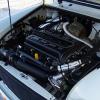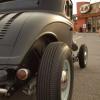Hello!
I'm just wondering what's the process in making patches for welding to replace rusty bits? I'm confused as how you would match the size, curves and angles that are involved in the original metal, and how to do it so that it doesn't look like you've just sticky taped a metal sheet on it?
Also, when welding how do the patch and the metal being patched manage to make a neat join. Surely 2 unstraight lines cut into 2 seperate pieces of metal are going to line up exactly?
thanks!

fashioning patches?
Started by
OllyD
, May 27 2006 05:52 PM
5 replies to this topic
#1

Posted 27 May 2006 - 05:52 PM
#2

Posted 27 May 2006 - 06:09 PM
the edges are the easy bits. you just lay it on top of the hole and trim until it fits. It doesn't need to be ultra-precise as the welding process will "fill" the gaps to a degree.
The hard part is the curves, bends and radii on them. it's really a question of marking things out, measuring them up, laying up, marking again etc etc. some bits can be a right PITA, and you may even need a little gas torch to heat the metal to allow it to become pliable enough to form some double or compound curves.
The other "simpler" way is to keep the bits you cut out, and use them as a sort of "template". obviously most of them will have some curvature missing or even bloomin great holes in (or you wouln'd be cutting them out and replacing them!).
The only way to really see whats involved is to do it. Use some offcuts of pieces to fill the smaller holes, and you'll soon find out what it takes. Work from there upto the more complicated bits. Oddly, larger panels can be sometimes easier to do as you have more area to play with and get right!
Oh, and one last thing, if you need holes for mounting things in these patches, then very accurately take masurements from the edges of the holes AND the edges of parts adjacent that aren't moving anywhere so that you can get them back in the right place. Whether you drill them before you finish the panel, or after its welded really is upto the position of some though.
The hard part is the curves, bends and radii on them. it's really a question of marking things out, measuring them up, laying up, marking again etc etc. some bits can be a right PITA, and you may even need a little gas torch to heat the metal to allow it to become pliable enough to form some double or compound curves.
The other "simpler" way is to keep the bits you cut out, and use them as a sort of "template". obviously most of them will have some curvature missing or even bloomin great holes in (or you wouln'd be cutting them out and replacing them!).
The only way to really see whats involved is to do it. Use some offcuts of pieces to fill the smaller holes, and you'll soon find out what it takes. Work from there upto the more complicated bits. Oddly, larger panels can be sometimes easier to do as you have more area to play with and get right!
Oh, and one last thing, if you need holes for mounting things in these patches, then very accurately take masurements from the edges of the holes AND the edges of parts adjacent that aren't moving anywhere so that you can get them back in the right place. Whether you drill them before you finish the panel, or after its welded really is upto the position of some though.
#3

Posted 27 May 2006 - 06:10 PM
this is were my many days of watching TV pay off. watching discovery channel you see americs fixing up their cars alot so this is what i know.
for making a patch you just cut out the patch you need. not exsact around the rust a big square or whatever shape works. then using what yoy just cut out as a template make a new bit of metal or use some card. as for the curves you beat the metal or use an english wheel to get the desired shape. or for us lot who don't own an english wheel nick a bit from another mini in the same area for all the curves of the metal.
as for the welding of the metal is the correct size of the hole which is should be you just mig tac it into place then run a bead around. althought being sheel you got to be careful not to warm the metal thro heat. beacuse mig has a filler metal like alot of welding the filler metal fills in the gap.
think that covers it....now to wait till someone far smarter than me comes along and says that i'm comptle wrong.

edit,
damn pikey you fast.
for making a patch you just cut out the patch you need. not exsact around the rust a big square or whatever shape works. then using what yoy just cut out as a template make a new bit of metal or use some card. as for the curves you beat the metal or use an english wheel to get the desired shape. or for us lot who don't own an english wheel nick a bit from another mini in the same area for all the curves of the metal.
as for the welding of the metal is the correct size of the hole which is should be you just mig tac it into place then run a bead around. althought being sheel you got to be careful not to warm the metal thro heat. beacuse mig has a filler metal like alot of welding the filler metal fills in the gap.
think that covers it....now to wait till someone far smarter than me comes along and says that i'm comptle wrong.
edit,
damn pikey you fast.
#4

Posted 27 May 2006 - 06:19 PM
I know! 
I did forget to mention the techniques in bending panels though!
As most of us tend not to have sheet metal breaks and english wheels in the back of our garages, it takes a lot of work with vices, hammers & dollies, tin snips, various adjustabls spanners and pliers and mole grips to get things bent. As I said previously, radii on the outer panels are the hardest to match, and bascially takes a lot of practise to judge where to grip things, what to bend things over and where to hit them.
I've found the easiest method is to get a few of the larger panels that you will need to completley replace, and use the offcuts from them as the basics, and work on the principle that if you need to patch a single panel more than 4 times, then it becomes more sensible to just buy the panel, and cut the old one out. That obviously depends on the panel concerned though (if you have to remove 6 panels to get at it, then its not a particularly good idea! )
)
Oh, and one last thing (i'll shut up then! ), get an old offcut of crpet in the garage. preferably a nice deel pile. It's dead handy for creating very slight curves in sheets. (just hit it with a hammer, and it creates a nice slight "curve"!). cheaper than a proper bodyworkers leather bag too!
), get an old offcut of crpet in the garage. preferably a nice deel pile. It's dead handy for creating very slight curves in sheets. (just hit it with a hammer, and it creates a nice slight "curve"!). cheaper than a proper bodyworkers leather bag too! 
I did forget to mention the techniques in bending panels though!
As most of us tend not to have sheet metal breaks and english wheels in the back of our garages, it takes a lot of work with vices, hammers & dollies, tin snips, various adjustabls spanners and pliers and mole grips to get things bent. As I said previously, radii on the outer panels are the hardest to match, and bascially takes a lot of practise to judge where to grip things, what to bend things over and where to hit them.
I've found the easiest method is to get a few of the larger panels that you will need to completley replace, and use the offcuts from them as the basics, and work on the principle that if you need to patch a single panel more than 4 times, then it becomes more sensible to just buy the panel, and cut the old one out. That obviously depends on the panel concerned though (if you have to remove 6 panels to get at it, then its not a particularly good idea!
Oh, and one last thing (i'll shut up then!
#5

Posted 28 May 2006 - 06:32 PM
This-------------------------------------------------------------From This
#6

Posted 28 May 2006 - 06:44 PM
The fitting replacement patches bit has been covered already in this post, but I hope you are cutting out the rot and fitting new metal into its place and not just covering it over with new metal...
As for shaping the metal, use your thigh or knee to bend it over, or check the shapes of stuff in the garden of street. The curb edge is a good one and also the top of those little tomb stone type water or gas tap markers you find at the edge of the pavement is good too. You don't need expensive tools, just use your initiative. If its not perfect then you can put a small skim of filler over it to bring it up.
As for shaping the metal, use your thigh or knee to bend it over, or check the shapes of stuff in the garden of street. The curb edge is a good one and also the top of those little tomb stone type water or gas tap markers you find at the edge of the pavement is good too. You don't need expensive tools, just use your initiative. If its not perfect then you can put a small skim of filler over it to bring it up.
0 user(s) are reading this topic
0 members, 0 guests, 0 anonymous users

















